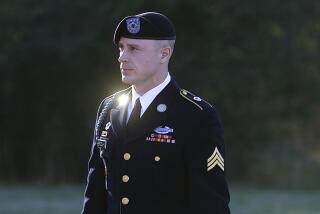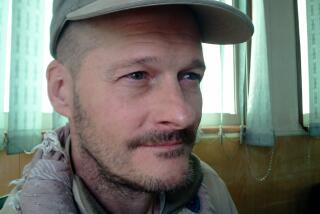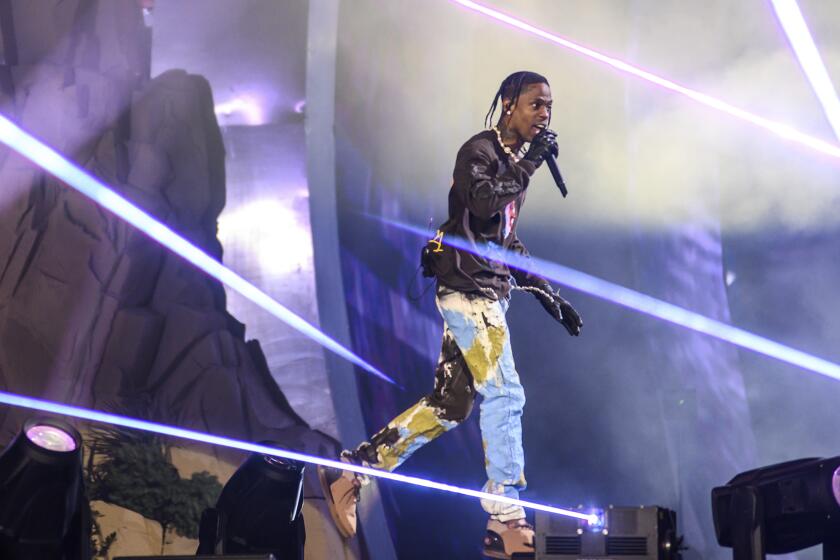Video of Bowe Bergdahl handover a media coup for the Taliban
The scene opens to a dirt road, scrubby hills, masked fighters and a lone figure sitting in a silver pickup. The camera zooms in and the figure takes shape: dressed in white, shaved head, smooth face, the nearly forgotten soldier who, in the latest footage from America’s longest war, waits with his captors as a Black Hawk helicopter skims toward him through a sky of broken clouds.
The Taliban’s handover last weekend of U.S. Army Sgt. Bowe Bergdahl to U.S. forces was a dramatic meeting of enemies caught on video that whirled across social media, TV news bulletins and YouTube on Wednesday. The video was a reminder that America’s wars against Islamist militants occasionally veer off the battlefield into propaganda and manipulation.
The Afghan war may have become a faint distraction for many Americans consumed by the Kardashians and Washington gridlock, but the vivid if grainy video crystallized attention on the conflict in a powerful and succinct way. The harsh terrain of eastern Afghanistan where Bergdahl was released resembled a movie set, and the 18 militants, brandishing rifles and rocket-propelled grenades, looked like extras.
The mood intensified as rarely glimpsed special forces — dressed casually in jeans with Bedouin scarves wrapped around unruly hair — hurried through a scrim of dust toward Bergdahl, who looked startled and confused and wore traditional Afghan robes. He was patted down and searched for weapons by U.S. forces before stepping into the helicopter on the same day that Washington released five Taliban commanders in Qatar.
“Don’t come back to Afghanistan,” a gunman tells the 28-year-old Bergdahl in the Afghan language of Pashto. “You won’t make it out alive next time.”
News coverage of the Afghan war “has been dropping off, but this [case] has pushed it up on the agenda,” said Daniel C. Hallin, professor of communication at UC San Diego. “It’s a personal story, a controversial one and it becomes a partisan football. Did Obama do the right thing, or is he in the company of traitors? … It was a really good photo op for the Taliban, their own video with their own spin on it.”
The 17-minute video was a media coup for the Taliban, allowing them to edit and frame images to show their followers — and much of the Islamic world — that they stood as equals to American power. Militant Islamists have released videos for years; they have become more polished and pointed in their messages. They are a low-budget, high-impact counter weapon for radicals who are outgunned, live in stealth yet crave the spotlight to advance their aims.
The video showed two Americans quickly shaking hands with fighters whose faces were hidden by scarves. The Taliban, who narrated the video, appeared a bit miffed that their interlocutors were short on pleasantries. “We wanted to convey some message to them through an interpreter, but they didn’t want to spend much time with us,” one militant says. “They didn’t even let us shake hands with the soldier [to] say goodbye, and they behaved in a very simple way.”
Hostage videos and other photographic images from war zones are potent glimpses into what otherwise would appear indescribable: the beheading of Daniel Pearl, the ghoulish photos from Abu Ghraib, the strange poetry of Osama bin Laden and countless men brandishing swords and weapons in dim rooms while shouting “God is great” into the red light of a lens. The video is part of the process, an accouterment of the age.
With his clean face and darting eyes, Bergdahl was reminiscent of the fictional Nick Brody on “Homeland,” an inscrutable POW. But he was also another turn in the face of a real war — the soldier who five years ago disappeared from his unit and now faces the embrace of his parents and the derision of fellow warriors who regard him as a deserter. And the rest of America can watch, argue, take sides and recall other images that both bonded and divided us as we hunkered around “Morning Joe,” Jon Stewart and “The O’Reilly Factor.” Twitter was filled with conjecture, rumors and mini-screeds: Oliver North @TrunewsRadio said, “I know a ransom of $5-6 million was paid to free Bergdahl.” Katie Pavlich tweeted “not only did good men die for Bergdahl, looks like good men also lost their limbs thx to Bergdahl.” On the other side, Propane Jane tweeted: “For the attacks against Obama to stick, Bergdahl/his family became the target of a character assassination crusade.”
The opinions of breathless experts and the experiences of former hostages were quickly stirred into the narrative. “That moment is electric. You know anything can happen,” Sean Langan, a British filmmaker captured by the Taliban in 2008, told ABC News in describing the moment of his release. “I remember thinking this is not the time to panic. I went into mental shutdown.”
This echoed against the anger from the mother of 2nd Lt. Darryn Andrews, who was reportedly killed during a search for Bergdahl. Sondra Andrews told the Army Times: “It gets really hurtful when I think, ‘This guy was worth my son’s life?’ My son who was patriotic? Who was a true soldier? Who defended his country with his life? That guy was worth that? I don’t think so.”
The video was as compelling as it was stark. Verses from the Koran were read as Bergdahl sat in a pickup, fighters scattered across a hillside and along a road. One man held a white flag on a big stick. Another stood at the open passenger-side door, talking to Bergdahl, who at one point appeared to wipe away a tear. Planes flew overhead.
The Black Hawk, rotors growing louder, flew in and landed. Bergdahl, carrying a bag, a scarf draped over his shoulder, was led from the truck to members of the American team. He was hurried to the helicopter, a flash of white in the dust.
More to Read
The biggest entertainment stories
Get our big stories about Hollywood, film, television, music, arts, culture and more right in your inbox as soon as they publish.
You may occasionally receive promotional content from the Los Angeles Times.







